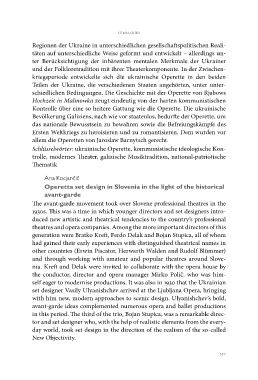Page 559 - Weiss, Jernej, ur./ed. 2021. Opereta med obema svetovnima vojnama ▪︎ Operetta between the Two World Wars. Koper/Ljubljana: Založba Univerze na Primorskem in Festival Ljubljana. Studia musicologica Labacensia, 5
P. 559
summaries
Regionen der Ukraine in unterschiedlichen gesellschaftspolitischen Reali-
täten auf unterschiedliche Weise geformt und entwickelt – allerdings un-
ter Berücksichtigung der inhärenten mentalen Merkmale der Ukrainer
und der Folkloretradition mit ihrer Theaterkomponente. In der Zwischen-
kriegsperiode entwickelte sich die ukrainische Operette in den beiden
Teilen der Ukraine, die verschiedenen Staaten angehörten, unter unter-
schiedlichen Bedingungen. Die Geschichte mit der Operette von Rjabows
Hochzeit in Malinowka zeugt eindeutig von der harten kommunistischen
Kontrolle über eine so heitere Gattung wie die Operette. Die ukrainische
Bevölkerung Galiziens, nach wie vor staatenlos, bedurfte der Operette, um
das nationale Bewusstsein zu bewahren sowie die Befreiungskämpfe des
Ersten Weltkriegs zu heroisieren und zu romantisieren. Dem wurden vor
allem die Operetten von Jaroslaw Barnytsch gerecht.
Schlüsselwörter: ukrainische Operette, kommunistische ideologische Kon-
trolle, modernes Theater, galizische Musiktradition, national-patriotische
Thematik
Ana Kocjančič
Operetta set design in Slovenia in the light of the historical
avant-garde
The avant-garde movement took over Slovene professional theatres in the
1930s. This was a time in which younger directors and set designers intro-
duced new artistic and theatrical tendencies to the country’s professional
theatres and opera companies. Among the more important directors of this
generation were Bratko Kreft, Ferdo Delak and Bojan Stupica, all of whom
had gained their early experiences with distinguished theatrical names in
other countries (Erwin Piscator, Herwarth Walden and Rudolf Blümmer)
and through working with amateur and popular theatres around Slove-
nia. Kreft and Delak were invited to collaborate with the opera house by
the conductor, director and opera manager Mirko Polič, who was him-
self eager to modernise productions. It was also in 1930 that the Ukrainian
set designer Vasily Ulyanishchev arrived at the Ljubljana Opera, bringing
with him new, modern approaches to scenic design. Ulyanishchev’s bold,
avant-garde ideas complemented numerous opera and ballet productions
in this period. The third of the trio, Bojan Stupica, was a remarkable direc-
tor and set designer who, with the help of realistic elements from the every-
day world, took set design in the direction of the realism of the so-called
New Objectivity.
557
Regionen der Ukraine in unterschiedlichen gesellschaftspolitischen Reali-
täten auf unterschiedliche Weise geformt und entwickelt – allerdings un-
ter Berücksichtigung der inhärenten mentalen Merkmale der Ukrainer
und der Folkloretradition mit ihrer Theaterkomponente. In der Zwischen-
kriegsperiode entwickelte sich die ukrainische Operette in den beiden
Teilen der Ukraine, die verschiedenen Staaten angehörten, unter unter-
schiedlichen Bedingungen. Die Geschichte mit der Operette von Rjabows
Hochzeit in Malinowka zeugt eindeutig von der harten kommunistischen
Kontrolle über eine so heitere Gattung wie die Operette. Die ukrainische
Bevölkerung Galiziens, nach wie vor staatenlos, bedurfte der Operette, um
das nationale Bewusstsein zu bewahren sowie die Befreiungskämpfe des
Ersten Weltkriegs zu heroisieren und zu romantisieren. Dem wurden vor
allem die Operetten von Jaroslaw Barnytsch gerecht.
Schlüsselwörter: ukrainische Operette, kommunistische ideologische Kon-
trolle, modernes Theater, galizische Musiktradition, national-patriotische
Thematik
Ana Kocjančič
Operetta set design in Slovenia in the light of the historical
avant-garde
The avant-garde movement took over Slovene professional theatres in the
1930s. This was a time in which younger directors and set designers intro-
duced new artistic and theatrical tendencies to the country’s professional
theatres and opera companies. Among the more important directors of this
generation were Bratko Kreft, Ferdo Delak and Bojan Stupica, all of whom
had gained their early experiences with distinguished theatrical names in
other countries (Erwin Piscator, Herwarth Walden and Rudolf Blümmer)
and through working with amateur and popular theatres around Slove-
nia. Kreft and Delak were invited to collaborate with the opera house by
the conductor, director and opera manager Mirko Polič, who was him-
self eager to modernise productions. It was also in 1930 that the Ukrainian
set designer Vasily Ulyanishchev arrived at the Ljubljana Opera, bringing
with him new, modern approaches to scenic design. Ulyanishchev’s bold,
avant-garde ideas complemented numerous opera and ballet productions
in this period. The third of the trio, Bojan Stupica, was a remarkable direc-
tor and set designer who, with the help of realistic elements from the every-
day world, took set design in the direction of the realism of the so-called
New Objectivity.
557


